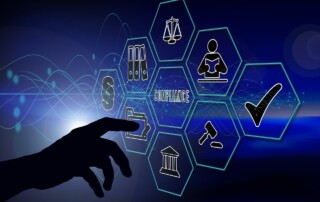At IITRun, we prioritize giving businesses knowledge and insight. To achieve this goal, we have provided publicly available resources. Feel free to take a look at our online brochures and references to thought leadership below. If you would like to receive regularly updated insights, take a look at our blog and subscribe to our newsletter.
Sample Academic References to Thought Leadership
These are references to many years of research and publications generated under R3Now.com.*
O’Leary, D. E. (2019). Technology life cycle and data quality: Action and triangulation. Decision Support Systems, 126, 113139.
Rusu, L., & Gerőcs-Szász, E. (2018). Extended ERP Using Restful Web Services Case Study: Winmentor Enterprise®. Journal of Information Systems & Operations Management, 249-256.
Parys, T. (2018). System ERP III przykładem zintegrowanego systemu informatycznego ery mobilnej komunikacji. Innowacje w zarządzaniu i inżynierii produkcji. T. 2, 664-672.
Sudhakar, R. M. (2017). Study on Opportunities Challenges and Cost Effective Information Technology Practices for Small and Medium Sized Enterprises.
Kraljić, A., & Kraljić, T. (2017). Agile Software Engineering Practices and ERP: Is a sprint too fast for ERP Implementation?.
Raposo, J. N. M. (2017). Avaliação do sucesso da adoção de um ERP no contexto de educação da gestão no ensino universitário (Doctoral dissertation).
García Sánchez, H. (2017). Análisis teórico de ERP y CRM. Implantación del ERP FacturaScripts en una PYME de servicios formativos.
Winter, R., Gubler, P., Wortmann, F., Elting, A., & Schultheis, W. (2016). Transformational IT Management. Handbook of Business Transformation Management Methodology (pp. 173-196). Routledge.
ASBBS Proceedings (2015); American Society of Business and Behavioral Sciences. San Diego 22(1), 425-431.
Surendro, K. (2015, March). Generic Quantitative Assessment Model for Enterprise Resource Planning (ERP) System. In International Conference on Soft Computing, Intelligence Systems, and Information Technology (pp. 563-571). Springer, Berlin, Heidelberg.
Boza, A., Cuenca, L., Poler, R., & Michaelides, Z. (2015). The interoperability force in the ERP field. Enterprise Information Systems, 9(3), 257-278.
ERP III The Promise of A New Generation (September 2014 Conference Paper) DOI: 10.13140/2.1.3906.1765. Proceeding of the 13th International Conference on Informatics in Economy (ISSN: 2247 – 1480), Education, Research & Business Technologies (Bucharest, Romania).
Accepted Definition for ERP III (Next Gen ERP) for the African (Zimbabwe) Higher Education system. http://www.esefa.uct.ac.za/esefa/about/enterprise-systems (retrieved March 2, 2015).
Gordon, M., & Dyer, J. N. (2014). Six Rules for Implementation of the General Ledger in SAP ERP. International Journal of Business Research, 14(1):7-16, ISSN: 1555-1296.
Ogunyemi, O. F., & Olofinsao, A (2014). A Case Study Analysis of Factors (Success and Failure) Affecting Enterprise Resource Planning System Implementation in Nigeria.
Vasilev, J. (2013, December). The change from ERP II to ERP III systems. In 3rd International Conference on Application of Information and Communication Technology and Statistics in Economy and Education (ICAICTSEE 2013).
Clegg, B., & Wan, Y. (2013). Managing enterprises and ERP systems: a contingency model for the enterprization of operations. International Journal of Operations & Production Management, 33(11/12), 1458-1489.
Ogunyemi, O. F. (2013) The Aftermath of International Financial Reporting Standards Systems Implementation in Nigeria. A Case Study of a Financial Organisation.
Blazer, C. (2012). Majority of Enterprise Resource Planning (ERP) Projects Fail–M-DCPS Is a Rare Exception. Information Capsule. Volume 1108.Research Services, Miami-Dade County Public Schools (US Federal Government Education Repository)
Shah, S. I. H., Khan, A. Z., Bokhari, R. H., & Raza, M. A. (2011). Exploring the impediments of successful ERP implementation: A case study in a public organization. International Journal of Business and Social Science, 2(22), 289-296.
Shah, S. I. H., Bokhari, R. H., Hassan, S., Shah, M. H., & Ali, M. (2011). Socio-technical factors affecting ERP implementation success in Pakistan: An empirical study. Australian Journal of Basic and Applied Sciences, 5(3), 742-749.
Presentations and Other Thought Leadership
SAP developed presentation on “The Art and Science of Change in SAP Implementations: Lessons from 3 Continents” (ACMP Nov 2011), slide 34.
Cisco Whitepaper/ebook on SAP Solution Manager (2013) “Unlocking the value in SAP Solution Manager”.
Doane, Michael (2012) The SAP® Green Book, A Business Guide for Effectively Managing the SAP Lifecycle , Galileo Press ISBN-13: 978-1592294077. Directly quoted in various chapters.
Sage: Solving Real Business Issues During the ERP Selection Process (Focus Experts, 2012).
Wailgum, Thomas (March 21, 2012) SAP Customer Upgrades to ECC 6.0: To Upgrade or Not to Upgrade. ASUG News.
RedCommerce: 10 SAP Tweeters to Follow 2011 (Oct 20, 2011)
Creating a Center of Excellence, June 17, 2011. GA ASUG.
RedCommerce: Ten SAP Related Tweeters to Follow (Nov 9, 2010)
Screening Methods to find the right SAP Consultant, May 30, 2008. NC ASUG.
_______________________________________________________
*IITRun is a DBA (Doing Business As) of R3Now Consulting and under the same leadership.
SAP’s 2027 Business Suite 7 Deadline Changes Back to 2025
This was j [...]
Tackling Common SAP Headaches: Dependency on Key Personnel
After mon [...]
Tackling Common SAP Headaches: Regulatory Compliance
In the com [...]




